Dispersion forces - Study guides, Class notes & Summaries
Looking for the best study guides, study notes and summaries about Dispersion forces? On this page you'll find 692 study documents about Dispersion forces.
All 692 results
Sort by
 Popular
Popular
-
HESI A2 ENTRANCE EXAM: READING COMPREHENSION, CHEMISTRY, GRAMMAR, BIOLOGY, VOCABULARY & GENERAL KNOWLEDGE, CRITICAL THINKING, ANATOMY & PHYSIOLOGY AND MATH
- Exam (elaborations) • 81 pages • 2024
-
- $8.99
- 3x sold
- + learn more
HESI A2 ENTRANCE EXAM: READING COMPREHENSION, CHEMISTRY, GRAMMAR, BIOLOGY, VOCABULARY & GENERAL KNOWLEDGE, CRITICAL THINKING, ANATOMY & PHYSIOLOGY AND MATH VERSION 2 (With answers) Reading Comprehension Neurologists and biological psychologists have witnessed a sharp increase in the knowledge and understanding of particular structures of the brain over the past two decades. As technology becomes ever more advanced, scientists are able to isolate the functions of even small regions of ...
 Popular
Popular
-
Test Bank for Fundamentals of Physics, Extended, 12th Edition by David Halliday
- Exam (elaborations) • 957 pages • 2024 Popular
-
- $29.49
- 2x sold
- + learn more
Test Bank for Fundamentals of Physics, Extended, 12e 12th Edition by David Halliday, Robert Resnick, Jearl Walker. Full Chapters test bank are included - Chapter 1 to 44 1 Measurement 1 1.1 Measuring Things, Including Lengths 1 1.2 Time 5 1.3 Mass 6 2 Motion Along a Straight Line 13 2.1 Position, Displacement, and Average Velocity 13 2.2 Instantaneous Velocity and Speed 18 2.3 Acceleration 20 2.4 Constant Acceleration 23 2.5 Free-Fall Acceleration 28 2.6 Graphica...
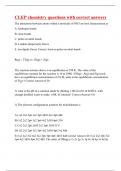
-
CLEP chemistry questions with correct answers
- Exam (elaborations) • 13 pages • 2023
- Available in package deal
-
- $14.49
- 1x sold
- + learn more
The attractions between atoms within a molecule of NH3 are best characterized as A. hydrogen bonds B. ionic bonds C. polar covalent bonds D. London (dispersion) forces E. ion-dipole forces Correct Answer-polar covalent bonds R(g) + 2T(g) ⇌ 2X(g) + Z(g) The reaction mixture above is at equilibrium at 298 K. The value of the equilibrium constant for the reaction is 16 at 298K. If R(g) , X(g) and Z(g) each have an equilibrium concentration of 2.0 M, what is the equilibrium concentrati...
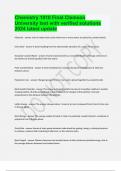
-
Chemistry 1010 Final Clemson University test with verified solutions 2024 latest update.
- Exam (elaborations) • 10 pages • 2024
- Available in package deal
-
- $14.99
- 1x sold
- + learn more
Molecule Unit of matter that results when two or more atoms are joined by covalent bonds Ionic Bond A bond resulting from the electrostatic attraction of a cation for an anion. Brainpower Read More Nonpolar Covalent Bond A bond characterized by an even distribution of charge; electrons in the bonds are shared equally by the two atoms Polar Covalent Bond A bond resulting from unequal sharing of bonding pairs of electrons between atoms Polyatomic Ions Charged g...

-
Solution Manual for Organic Chemistry Mechanistic Patterns Canadian 1st Edition by Ogilvie Ackroyd Br
- Exam (elaborations) • 811 pages • 2024
-
- $17.99
- 1x sold
- + learn more
Chapter 1 Carbon and Its Compounds CHECKPOINT PROBLEMS Practice Problem 1.1 a) S — 1s2 2s2 2p6 3s2 3p4 b) Cl — 1s2 2s2 2p6 3s2 3p5 c) Na+ — 1s2 2s2 2p6 1-2 Copyright © 2018 Nelson Education Limited Practice Problem 1.2 a) Count valence electrons. Build a basic bonding framework and account for electrons used. Add remaining electrons and check for formal charges. The molecule has a lone pair on the nitrogen. All other electrons are bonding electrons. b) Count valence electrons. Build a bas...
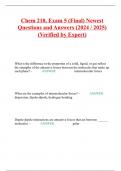
-
Chem 210, Exam 5 (Final) Newest Questions and Answers (2024 / 2025) (Verified by Expert)
- Exam (elaborations) • 23 pages • 2024
- Available in package deal
-
- $11.49
- + learn more
Chem 210, Exam 5 (Final) Newest Questions and Answers (2024 / 2025) (Verified by Expert) What is the difference in the properties of a solid, liquid, or gas reflect the strengths of the attractive forces between the molecules that make up each phase? - ANSWER intermolecular forces What are the examples of intermolecular forces? - ANSWER dispersion, dipole-dipole, hydrogen bonding
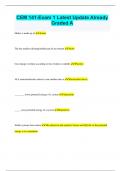
-
CEM 141-Exam 1 Latest Update Already Graded A
- Exam (elaborations) • 13 pages • 2024
- Available in package deal
-
- $9.99
- + learn more
CEM 141-Exam 1 Latest Update Already Graded A Matter is made up of Atoms The the smallest distinguishable part of an element Atom Can change overtime according to the evidence available Theories ALL atoms/molecules attract to one another due to Electrostatic forces ________ lower potential energy of a system Attractions _____ raise potential energy of a system Repulsions Stable systems form where The attractive and repulsive forces are EQUAL or the potential energy is at...
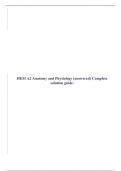
-
HESI A2 Anatomy and Physiology (answered) Complete solution guide.
- Exam (elaborations) • 50 pages • 2023
- Available in package deal
-
- $10.00
- 1x sold
- + learn more
HESI A2 Anatomy and Physiology. 1. Anatomic position 2. Which of the following is a structure found in the upper respiratory? 3. A person who has damage to their ulnar nerve will have decreases sensation in 4. Which bone dose not articulate with any other bone? 5. Which of the following statements best describe endocrine glands? 6. Diet is important because bone are storage places for 7. Which organ is part of both the male reproductive system and the urinary system? 8. Red blood cell production...
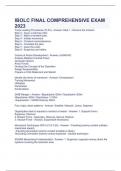
-
IBOLC FINAL COMPREHENSIVE EXAM 2023
- Exam (elaborations) • 4 pages • 2023
- Available in package deal
-
- $9.99
- 1x sold
- + learn more
Troop Leading Procedures (TLPs) - Answer- Step 1 - Receive the mission. Step 2 - Issue a warning order. Step 3 - Make a tentative plan. Step 4 - Initiate movement. Step 5 - Conduct reconnaissance. Step 6 - Complete the plan. Step 7 - Issue the order. Step 8 - Supervise and refine. Course of Action Development - Answer- (AGADAP) Analyze Relative Combat Power Generate Options Array Forces Develop the Concept of the Operation Assign Responsibility Prepare a COA Statement and Sketch ...
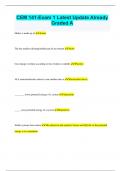
-
CEM 141-Exam 1 Latest Update Already Graded A
- Exam (elaborations) • 13 pages • 2024
-
- $9.99
- + learn more
CEM 141-Exam 1 Latest Update Already Graded A Matter is made up of Atoms The the smallest distinguishable part of an element Atom Can change overtime according to the evidence available Theories ALL atoms/molecules attract to one another due to Electrostatic forces ________ lower potential energy of a system Attractions _____ raise potential energy of a system Repulsions Stable systems form where The attractive and repulsive forces are EQUAL or the potential energy is at a minimum The ...
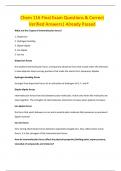
-
Chem 116 Final Exam Questions & Correct Verified Answers| Already Passed
- Exam (elaborations) • 14 pages • 2024
-
- $12.99
- + learn more
What are the 5 types of intermolecular forces? 1. Dispersion 2. Hydrogen bonding 3. Dipole-dipole 4. Ion-dipole 5. Ion-Ion Dispersion forces the weakest intermolecular force; a temporary attractive force that results when the electrons in two adjacent atoms occupy positions that make the atoms form temporary dipoles Hydrogen bonding forces stronger than dispersion forces its an attraction of hydrogen to O, F, and N Dipole-dipole forces intermolecular forces that exist between polar m...

Did you know that on average a seller on Stuvia earns $82 per month selling study resources? Hmm, hint, hint. Discover all about earning on Stuvia


